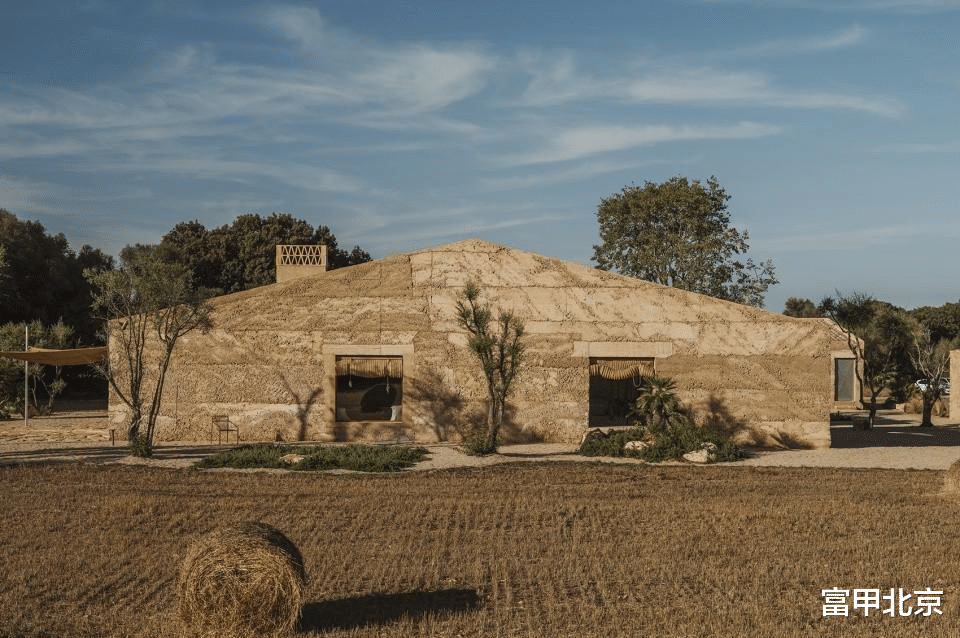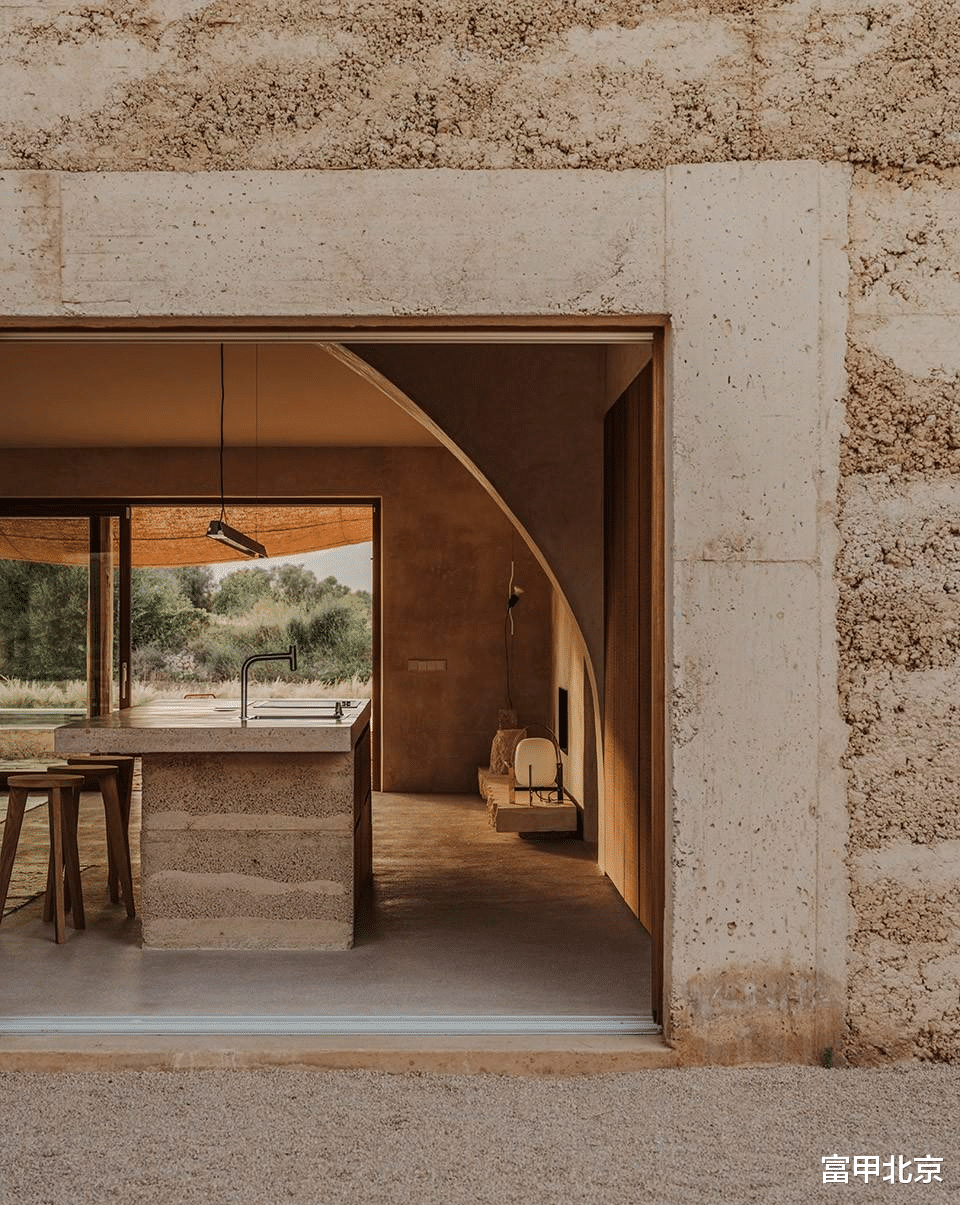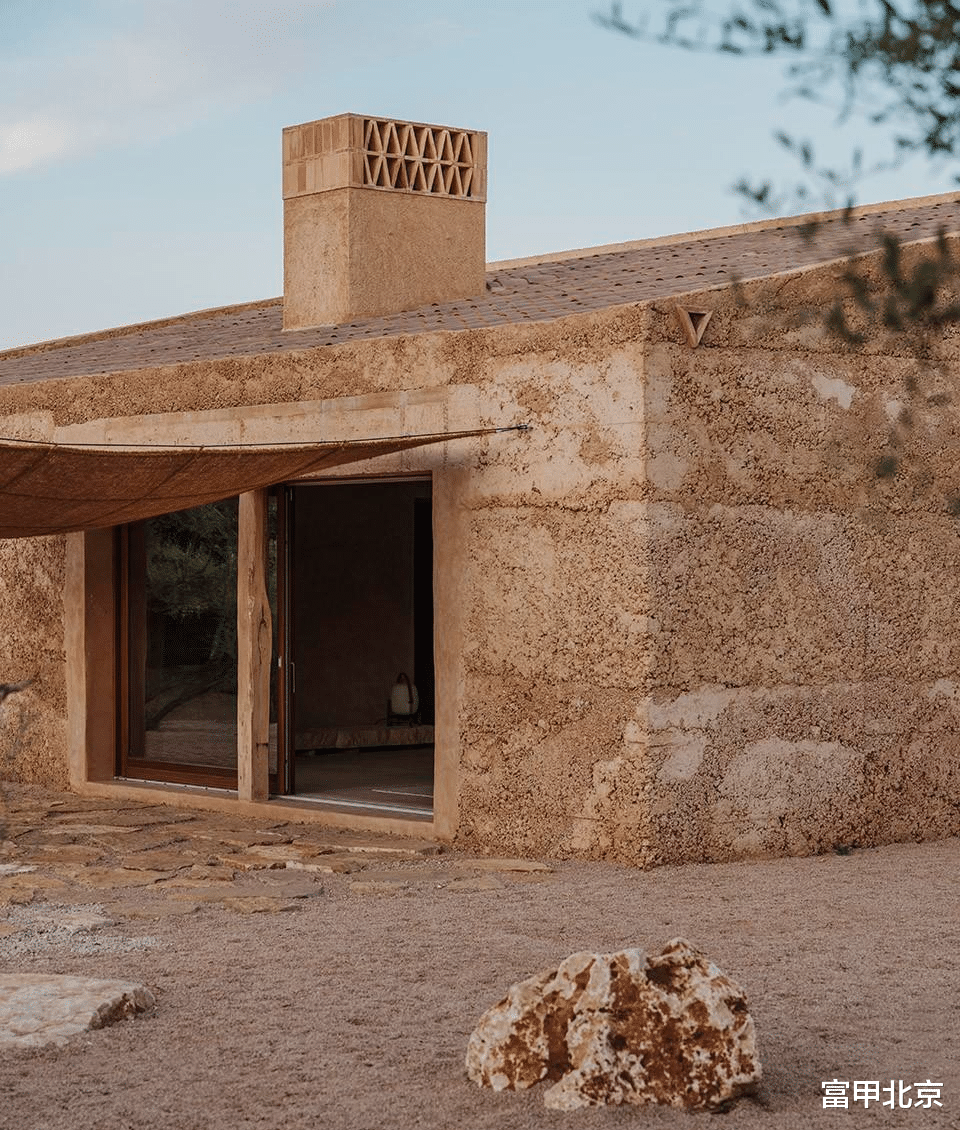在乡村生活意味着暴露在大自然中,也意味着一种开放的氛围。为了解决这一问题,该住宅采用了天井的概念,天井的面积与主宅的面积相等。
Living in the countryside means being exposed to the elements and a sense of openness. To counteract this, the house incorporates the concept of a patio, with a surface area equal to that of the main house.
▼项目概览,overall of the project©Ricard Lopez

这一精心设计的空间可以适应不断变化的需求,作为一处隐世的庇护所,人们在这里聚集,冥想或者参加各种活动。开放与封闭元素的交织营造了一种社群的氛围,容纳独处或者反省的时刻。空间的间隙不仅可以框住周围的景观,同时也让自然光倾泻进来,强调了这中氛围,并且营造了室外和室内环境之间的动态互动。
This thoughtfully designed space adapts to changing needs, serving as a sanctuary where people can gather, reflect, and engage. The interplay between open and closed elements fosters a sense of community while allowing for moments of solitude and introspection. The gaps not only frame the surrounding landscape but also invite natural light to filter in, enhancing the ambiance and creating a dynamic interaction between the interior and exterior environments.
▼项目外观,exterior of the project©Ricard Lopez

施工中使用的材料与自然环境融为一体,注重可持续性和环境之间的和谐相融。土壤,石灰和石头共同筑造了结构,体现了对传统建造技术的沿用和对当地资源的使用。这一建筑绿洲验证了如何在人类智慧和自然世界之美之间保持平衡,提供了一处庇护和联系的场所。
The materials used in the construction blend seamlessly with the natural surroundings, emphasizing sustainability and harmony with the environment. Earth, lime, and stones come together to form the structure, reflecting a commitment to traditional building techniques and local resources. This architectural oasis stands as a testament to the balance between human ingenuity and the beauty of the natural world, offering a place of refuge and connection.
▼使用的材料与自然环境融为一体,materials used in the construction blend seamlessly with the natural surroundings©Ricard Lopez

这一住宅集营造了可供居住的等级空间,被设想为一个可发生各种境况的多功能边界。这里是一个遮风避雨的围合结构,可以遮挡阳光、风和广袤的田野,将人们围在一个半封闭的区域内,同时又留出空隙让人们欣赏美景。
The cluster creates a hierarchical space meant to be occupied, envisioned as a versatile boundary where various situations can occur. It is a sheltered enclosure, providing protection from the sun, the wind, and the vastness of the field, enclosing you in a semi-closed area while opening gaps that offer views.
▼遮风避雨的围合结构,a sheltered enclosure©Ricard Lopez


▼通向室外的窗户,window towards the outdoor©Ricard Lopez

绿洲OASIS
绿洲这一词被定义为:“喘息、休息、经受生活挫折后的避难所”。而这一建筑上的绿洲概念则意味着:植被、水,与周围景观隔绝,也是重要的庇护所。
The term oasis is defined as “respite, rest, refuge in the penalties or setbacks of life”. This concept of architectural oasis: vegetation, water, isolated from the surrounding landscape and also as a vital shelter.
▼植被绿洲,oasis with vegetation©Ricard Lopez


这一空隙创造了一个作为辅助生活区的空间。它更具有公共性,但仍然提供了必要的私密感。这种空间上的对立唤起了人们对一座没有屋顶、饱经岁月风霜的房屋的记忆。
The void creates a space that serves as a secondary living area. It’s more public, yet still provides the necessary intimacy. This spatial dichotomy evokes the memory of a house without a roof, weathered by the passage of time.
▼辅助生活区的空间,serves as a secondary living area©Ricard Lopez


Ballast工艺Ballast
Ballast是自1950年代就于Mallorca开始运用的一种当地工艺。这一建造系统基于一种承重墙(夯土混合不同尺寸的石头以及石灰混合物)。室内隔墙的ballast有25厘米厚,并包括10厘米的木制纤维保温层和20厘米的当地陶土砖墙。通过在两面墙之间铺设渗透膜来实现防水,以确保围护结构的透气性。
Ballast is a local technique that was used in Mallorca in the 1950s. The construction system is based on ballast walls (soil mixed with aggregates of various sizes, stone, and lime). For the interior enclosure walls, the ballast is 25 cm thick, with 10 cm of wood fiber insulation and a 20 cm thick local ceramic brick wall. Waterproofing is achieved with an open diffusion membrane placed between the two walls to ensure the breathability of the enclosures.
▼运用Ballast工艺, using Ballast technology©Ricard Lopez

为了应对潮湿,渗透膜变得极为重要,这样既能保证适当的通风,又能防止潮气积聚导致结构损坏。这一防水举措维系了建筑整体的持久性,同时保持了一个健康的室内环境。通过融合传统材料和现代技艺,ballast墙体系在功能性和可持续性之间营造了和谐平衡,体现了对于环境和建筑原则的尊重。
The open diffusion membrane is crucial in managing moisture, allowing for proper ventilation and preventing the accumulation of dampness that can lead to structural damage. This approach to waterproofing supports the overall longevity of the building while maintaining a healthy indoor environment. By combining traditional materials with modern techniques, the ballast wall system creates a harmonious balance between functionality and sustainability, reflecting a deep respect for both environmental and architectural principles.
▼对于环境和建筑原则的尊重,a deep respect for both environmental and architectural principles©Ricard Lopez


室内泥土抹灰Interior Earthen Plaster
室内环境中,隔墙表面粉刷有泥土和石灰的混合物,为潮湿的气候创造一种有利的湿热环境。这一传统工艺不仅仅有助于提高建筑的保温性能,还通过调节湿度来提高室内空气质量。这一举措不仅仅降低了能耗,也降低了发霉和冷凝的风险,尤其是在这样的高湿度地区。不仅如此,对于当地材料的使用也和房屋的可持续性建造原则相符合,提供环境和经济上的益处。
Inside, the partitions are coated with a blend of earth and lime, creating a favorable hygrothermal environment for our humid climate. This traditional technique not only enhances the thermal performance of the building but also contributes to better indoor air quality by regulating humidity levels. This approach not only improves energy efficiency but also reduces the risk of mold and condensation, making it particularly suitable for regions with high humidity. Additionally, the use of local materials aligns with sustainable building practices, offering both environmental and economic benefits.
▼室内环境,indoor environment©Ricard Lopez

▼室内泥土抹灰,interior earthen plaster©Ricard Lopez


▼卧室,bedroom©Ricard Lopez

▼卧室,bedroom©Ricard Lopez

稻草覆层Straw Coverage
屋顶运用放置在层压木梁上的长35厘米宽40厘米高80厘米的稻草垛来保温。这一设计形成了一个致密的一体化隔热层,其隔热性能优于 30 厘米的外露型的聚苯乙烯。稻草垛不仅仅提供卓越的保温性能,还通过运用自然的可循环的材料来实现建筑的可持续原则。稻草和层压木的组合提高了建筑的整体节能效率,有助于有效调节室内温度。
The roof is insulated using straw blocks measuring 35x40x80 cm, which are placed between laminated wood beams. This setup creates a dense and well-integrated insulation layer that provides thermal performance superior to 30 cm of extruded polystyrene. The straw blocks not only offer excellent insulation properties but also contribute to sustainable building practices by utilizing natural, renewable materials. The combination of straw and laminated wood enhances the overall energy efficiency of the building, helping to regulate indoor temperatures effectively.
▼屋顶,roof©Ricard Lopez

▼使用的稻草,using straw from the local©Ricard Lopez

被包裹在梁之间的稻草垛形成了一个坚固的保温屏障,不仅降低了热量丧失还提高了室内舒适度。不仅如此,这一自然的保温材料还有助于调节湿度和渗透性,对于保持健康的室内气候至关重要。对于稻草的使用也符合环境友好的建造原则,降低了对合成材料的依赖和建筑对环境的影响。这一方法有助于延长建筑的使用寿命,因为稻草既有韧性又能有效营造舒适的居住环境,同时还能促进可持续建筑实践。
The straw blocks, encased between the beams, form a robust thermal barrier that minimizes heat loss and improves indoor comfort. Additionally, this natural insulation material supports moisture regulation and breathability, crucial for maintaining a healthy indoor climate. The use of straw aligns with eco-friendly construction principles, reducing reliance on synthetic materials and lowering the environmental impact of the building. This method also contributes to the building’s durability, as straw is both resilient and effective in creating a comfortable living environment while promoting sustainable construction practices.
▼傍晚,dusk©Ricard Lopez

▼傍晚,dusk©Ricard Lopez


